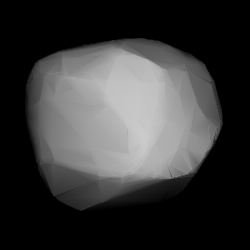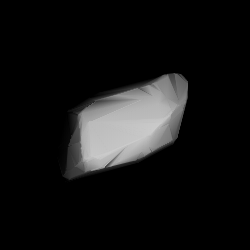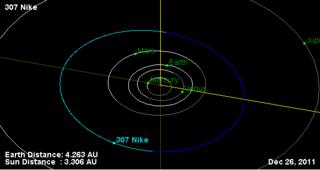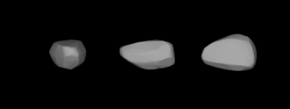
62 Erato is a carbonaceous Themistian asteroid from the outer region of the asteroid belt, approximately 95 kilometers in diameter. Photometric measurements during 2004–2005 showed a rotation period of 9.2213±0.0007 h with an amplitude of 0.116±0.005 in magnitude. It is orbiting the Sun with a period of 5.52 yr, a semimajor axis of 3.122 AU, and eccentricity of 0.178. The orbital plane is inclined by an angle of 2.22° to the plane of the ecliptic.

100 Hekate is a large main-belt asteroid.

159 Aemilia is a large main-belt asteroid. Aemilia was discovered by the French brothers Paul Henry and Prosper Henry on January 26, 1876. The credit for this discovery was given to Paul. It is probably named after the Via Aemilia, a Roman road in Italy that runs from Piacenza to Rimini.

244 Sita is a background asteroid from the inner region of the asteroid belt, approximately 11 kilometers in diameter. It was discovered on 14 October 1884, by an Austrian astronomer Johann Palisa in the Vienna Observatory. It was named for the Hindu deity Sita.

258 Tyche is a relatively large main belt asteroid discovered by Robert Luther at Düsseldorf-Bilk Observatory on 4 May 1886. The stony S-type asteroid measures about 65 kilometers in diameter and has a perihelion of 2.1 AU.

281 Lucretia is an asteroid belonging to the Flora family in the Main Belt. It was discovered by Austrian astronomer Johann Palisa on 31 October 1888 in Vienna, and is named after the middle name of Caroline Herschel, one of the first female astronomers. Light curves of this asteroid show a synodic rotation period of 4.349±0.001 h with an amplitude of 0.3–0.4 magnitude. The spin axis appears nearly perpendicular to the ecliptic.

291 Alice is a stony background asteroid from the inner region of the asteroid belt. It was discovered by Johann Palisa on 25 April 1890 at the Vienna Observatory.

292 Ludovica is a main belt asteroid.

307 Nike is a sizeable asteroid of the asteroid belt. It was discovered by Auguste Charlois on 5 March 1891 while working at the Nice Observatory. Charlois named it after the Greek goddess of victory, as well as the Greek name for the city where it was discovered. Measurement of the light curve of this asteroid in 2000 indicates a rotation period of 7.902 ± 0.005 hours.

341 California is an asteroid belonging to the Flora family in the Main Belt. It was discovered by Max Wolf on 25 September 1892 in Heidelberg, and is named for the U.S. state of California. This object is orbiting the Sun at a distance of 2.20 AU with a period of 3.26 yr and an eccentricity (ovalness) of 0.19. The orbital plane is inclined at an angle of 5.7° to the plane of the ecliptic.

367Amicitia is a typical Main belt asteroid that is a member of the Flora family. It was discovered by Auguste Charlois on 19 May 1893 in Nice.

390 Alma is an asteroid from the intermediate asteroid belt, approximately 24 kilometers in diameter. It was Guillaume Bigourdan's only asteroid discovery. He discovered it on 24 March 1894 in Paris.
428 Monachia is an asteroid orbiting within the Flora family in the Main Belt.
538 Friederike is a minor planet orbiting in the asteroid belt. It is a member of the Hygiea family of asteroids.
630 Euphemia is a mid-sized Eunomian asteroid.

685 Hermia is an S-type asteroid belonging to the Flora family in the Main Belt. Its diameter is about 11 km and it has an albedo of 0.281.
700 Auravictrix is an asteroid belonging to the Flora family in the Main Belt. Its diameter is about 15 km and it has an albedo of 0.246. Its rotation period is 6.075 hours.

800 Kressmannia is an S-type asteroid belonging to the Flora family in the Main Belt. Its rotation period is 4.464 hours.
841 Arabella is an asteroid belonging to the Flora family in the Main Belt. Its rotation period is 3.39 hours. It is named after the title character from Richard Strauss' opera Arabella.
905 Universitas is an S-type asteroid orbiting in the Main belt as part of the Flora family. Its diameter is about 21 km and it has an albedo of 0.085. Its rotation period is approximately 14.2 hours.














